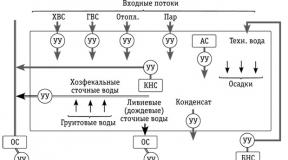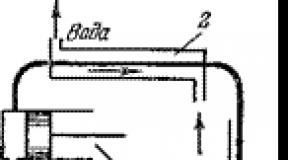The easiest way to make mash without yeast. How to cook mash without commercial yeast? Recipes for home brew. We put the mash on sourdough
Hello!
Today I will tell you how to make moonshine on wheat without yeast. In fact, not necessarily on wheat - any grain crops (rye, barley, millet, etc.) will do.
And of course, mash will not do without yeast and sugar. But we will not use the usual alcoholic or baker's yeast, but wild ones that live on the surface of the grain.
And although this is still a sugar moonshine (since the grain carbohydrates are not fermented), the soft work of wild yeast and the presence of cereals in the process give it a special original flavor. Moonshiners call this drink Wild Sam.
Moreover, each type of cereal gives the moonshine its own individual taste. Wheat makes one moonshine, from barley or rye - another. You can also collect a blend of different crops in any proportion. In general, there is a lot of room for imagination. Yes, and one more thing - mash on the same grain can be placed up to 4 times or more!
If you need a recipe for real grain moonshine, then you are here - simple recipe for moonshine from flour
Ingredients
In the recipe, I will give the proportions calculated for a 30 liter tank, because I actually use it. You count yourself for the container you need. The principle is this - take the volume of your fermentation tank and divide it by 7.5. The resulting figure will show the required amount of grain. And then for each kilogram of grain, 1 kg of sugar and 5 liters of water will be required.
And so, the ingredients:
- 4 kg of grain (I have wheat in the recipe and in the photo)
- 4 kg sugar
- 20 liters of water

The grain must be fodder, i.e. that which goes to animal feed. You can buy it on the market, grain storage, base, etc. Seed most likely will not work, because it is specially processed for storage. To moonshiners from St. Petersburg, I can tell you where suitable cheap grain is sold.
Mash preparation

It's the next day. Foam appeared:

On the second day:

On the day when confusion is ready:


Distillation
- We do the distillation of the mash as usual - without the selection of heads and tails, to water.
- You don't need to clean anything, nor coalnor oil etc.
- We do the second distillation according to all the rules. fractional distillation - with the selection of heads and tails. It is desirable to carry out the third distillation.

Recipe impressions
He made moonshine with wheat and barley. I liked wheat better - it turns out very soft. Perhaps even too much. On barley, it is tougher, but also very interesting.
It is said to work very well with a 50/50 mix of wheat and barley. I really want to try.
In general, I liked Wild Sam so much that I made special labels for him. Don't judge strictly, these are my first attempts at creating my own labels.

Ask why a boar? When I first tried this recipe, odor trap made loud grunting noises on the tank in the kitchen. At night they were clearly audible in our bedroom and my wife once said to me - “you have a pig in your kitchen that constantly wants to eat”. "And the pig is wild," I thought. That's why the boar is.
That's all. I hope the recipe is explained in an accessible way. If you have any questions - you are welcome in the comments.
Bye everyone,
Wheat moonshine has always been famous for its softness and ease of use. from such raw materials, the addition of sugar and yeast culture is most often meant, but you can do without them. The most budgetary, but the most laborious of all is the recipe for wheat moonshine without sugar and yeast at home. A bit of theory.
Wheat grains contain wild yeast and are suitable for making sourdough. At this stage, sugar will still need to be added, but a small amount is taken: it is necessary for yeast to multiply. Wheat itself is a starchy raw material that requires saccharification. If this procedure is carried out correctly, enough sugars will be released so that the alcohol yield is not scanty. Therefore, the recipe for moonshine without sugar and yeast is, albeit laborious, but still a reality.
Wheat must be clean, dry, of high quality and variety. Rotten grains affected by a fungus should not be used in any case. Often you still need to look for quality grain. For those whose searches were unsuccessful, we advise you to use it.
In total, a recipe for wheat moonshine without yeast will require 7 kg of grain.
Preparing a sourdough for a moonshine recipe on wheat without yeast.
Ingredients:
- wheat - 1 kg
- granulated sugar - 200 grams
- clean water - 1 l
Sourdough preparation:
- Remove garbage from wheat, do not wash grain.
- Dissolve sugar in warm water (35-36 ° C).
- Put the grain in a bowl or saucepan, cover with sweet water.
- Put the container to the battery or on a warm floor (if possible. The temperature should be set to 30-35 ° C).
- In 2-5 days, the leaven will start completely.
While the leaven is “starting up”, we prepare green malt, with the help of which enzymes we will carry out saccharification.
Cooking green malt for a sugar-free wheat moonshine recipe.
Ingredients:
- grain - 1.5 kg
- clean water - by eye
Making malt:
- Place the grain on a wide baking sheet or pan, level.
- Fill with water so that its level is level with the grain or exceeds the level of the grains by a couple of millimeters.
- Put the container in a warm place, cover with gauze.
- For 2-3 days, the grains should germinate, as soon as this happened, you can proceed to the next stage (3-4 days, respectively).
Saccharification of wheat. You will need a thermometer!
Ingredients:
- produced malt
- remaining wheat grains - 4.5 kg
- clean water - 15 l
Saccharification:
- Grind malt and grains into cereals, place in a container that can be heated.
- Heat the water to 80 ° С, pour the mixture of malt and grain with it and mix everything thoroughly.
- Measure the temperature of the mixture, if it is below 63 ° C, heat it on the stove to this temperature, then remove it from the stove, wrap it in a warm old blanket. Leave for 8-10 hours.
- After the specified time, make an iodine test. Iodine turns blue - starch is present, you still need to wait. Before adding the starter, measure the temperature of the wort - it should not exceed 35 ° C.
- Pour the sugared wheat wort into a fermentation vessel.
- Strain the sourdough, add to the wort.
- The fermentation process should begin within 2-5 hours.
- After 10-12 hours, close the container with a lid, install a water seal.
- In the first 2-3 days, it is recommended to stir the mash with a clean mixer.
- The fermentation process takes 4 to 10 days.
Distillation of mash into wheat moonshine without sugar and yeast
For the distillation of mash from wheat, you will need (we recommend choosing an apparatus with a distillation column of the brand). Not to be mistaken with the model and to make the right choice will help
Making moonshine and alcohol for personal use
absolutely legal!
After the end of the existence of the USSR, the new government stopped the fight against moonshine. Criminal liability and fines were canceled, and an article banning the production of alcohol-containing products at home was removed from the Criminal Code of the Russian Federation. To this day, there is not a single law prohibiting you and me from engaging in our favorite hobby - making alcohol at home. This is evidenced by the Federal Law of July 8, 1999 No. 143-FZ "On Administrative Liability of Legal Entities (Organizations) and Individual Entrepreneurs for Offenses in the Field of Production and Turnover of Ethyl Alcohol, Alcoholic and Alcohol-Containing Products" (Collected Legislation Russian Federation, 1999, N 28, art. 3476).
Excerpt from the Federal Law of the Russian Federation:
"The effect of this Federal Law does not apply to the activities of citizens (individuals) who produce products containing ethyl alcohol not for the purpose of marketing."
Home brewing in other countries:
In Kazakhstan in accordance with the Code of the Republic of Kazakhstan On Administrative Offenses of January 30, 2001 N 155, the following liability is provided. So, according to article 335 "Manufacture and sale of home-made alcoholic beverages" illegal manufacture for the sale of moonshine, chacha, mulberry vodka, home brew and other alcoholic beverages, as well as the sale of these alcoholic beverages entails a fine in the amount of thirty monthly calculation indices with confiscation of alcoholic beverages , devices, raw materials and equipment for their manufacture, as well as money and other valuables received from their sale. However, the law does not prohibit the preparation of alcohol for personal use.
In Ukraine and Belarus things are different. Articles No. 176 and No. 177 of the Code of Ukraine on Administrative Offenses provide for the imposition of fines in the amount of three to ten non-taxable minimum wages for the manufacture and storage of moonshine without the purpose of sale, for storage without the purpose of selling devices * for its production.
Article 12.43 repeats this information practically word for word. "Making or purchasing strong alcoholic beverages (moonshine), semi-finished products for their manufacture (mash), storage of devices for their manufacture" in the Code of the Republic of Belarus on Administrative Offenses. Clause No. 1 informs: "The production of strong alcoholic beverages (moonshine) by individuals, semi-finished products for their manufacture (mash), as well as the storage of devices * used for their manufacture, - entail a warning or a fine of up to five basic units with the confiscation of these drinks, semi-finished products and apparatus ".
* It is still possible to purchase moonshine stills for home use, since their second purpose is to distill water and obtain components for natural cosmetics and perfumery.
Wort fermentation is an integral part of the alcohol preparation process. Wine enthusiasts know the classic recipes for making mash using sugar, water and yeast. But many winemakers try to do without the activation of fermentation in order to get a natural product. And therefore the question: "How to make mash without yeast" is extremely relevant for such people. 
There are many options for making yeast-free mash. Its secret is that instead of yeast, components are put into the wort, which themselves can release fermentation products. For example, wheat is suitable for such purposes - this is the most common ingredient. Candied jam, honey, rice, dried fruits, apples, etc. are also suitable for mash.
Sugar wheat mash recipe very simple. Take 5 kg of wheat, rinse it thoroughly from dust and dirt, remove hollow grains. Then pour clean wheat into a previously prepared washed container, fill with cool water 1-2 cm above the grain level, add 1.5 kg of sugar and leave for the grain to germinate.
 The grain usually germinates within 3-5 days. When the wheat rises, add 15 liters of water to the container and add 5 kg of sugar. Place the container with the mash blank in a warm place with a temperature of 28-30 ° C for 5-10 days. Put a water seal on the container to monitor the readiness of the wash. Shake the wash container regularly and remove any foam or dirt that has accumulated on the surface.
The grain usually germinates within 3-5 days. When the wheat rises, add 15 liters of water to the container and add 5 kg of sugar. Place the container with the mash blank in a warm place with a temperature of 28-30 ° C for 5-10 days. Put a water seal on the container to monitor the readiness of the wash. Shake the wash container regularly and remove any foam or dirt that has accumulated on the surface.
There is another way to get such mash. Sprouted wheat must be dried and overlaid (after separating the sprouts), then it must be diluted with water in a ratio of 1: 3, add sugar (a glass of sugar per kg of grain) and put in a warm place. Instead of wheat, you can take rye, barley or corn.
 You can make mash without yeast and on rice... To do this, pour two glasses of peeled rice and three glasses of granulated sugar into a three-liter jar, pour in a half-liter can of beer there. Cover it with a cloth, gauze, or a water seal lid. Leave the container in a warm place with a temperature of 25-30 ° C, do not forget to shake it periodically and remove dirt from the surface. Usually, such a wash is ready after 10-12 days. Add dried apricots, raisins or prunes to the rice mash if desired.
You can make mash without yeast and on rice... To do this, pour two glasses of peeled rice and three glasses of granulated sugar into a three-liter jar, pour in a half-liter can of beer there. Cover it with a cloth, gauze, or a water seal lid. Leave the container in a warm place with a temperature of 25-30 ° C, do not forget to shake it periodically and remove dirt from the surface. Usually, such a wash is ready after 10-12 days. Add dried apricots, raisins or prunes to the rice mash if desired.
 In addition to this recipe, there are several more options, how to put the mash without yeast... For example, if you want to make homemade wine or distill aromatic moonshine, then you need fruits and berries for this. For such a wash, grapes, cherries, plums, apricots, pears, etc. are suitable. The raw materials do not need to be washed before cooking, since it contains natural unicellular mushrooms on its peel and skin, which, falling into a favorable environment, will begin to multiply, forming alcohol and carbon dioxide ...
In addition to this recipe, there are several more options, how to put the mash without yeast... For example, if you want to make homemade wine or distill aromatic moonshine, then you need fruits and berries for this. For such a wash, grapes, cherries, plums, apricots, pears, etc. are suitable. The raw materials do not need to be washed before cooking, since it contains natural unicellular mushrooms on its peel and skin, which, falling into a favorable environment, will begin to multiply, forming alcohol and carbon dioxide ...
Such a brew can be called yeast-free only conditionally, because in any case, natural yeast is still involved in the process. They ferment unevenly and longer than special yeast - 2-3 weeks. 
For example, plum yeast-free mash made from 12 kg of plums and 2 kg of sugar. The fruits should be thoroughly mash, add sugar and leave for 12-16 days. Another option for preparing such a mash, which is optimally suited for further distillation, is as follows: three buckets of plums must be crushed and left for 2 weeks. There is no need to add water or sugar. It is important to know that if you are making yeast-free mash on fruits or vegetables, then the fruits do not need to be washed, since there is natural yeast on the peel of the fruit. 
You can also make mountain ash mash... To do this, after the first hard frosts, collect the berries and squeeze the juice out of them. Leave in a warm place and watch for carbon dioxide release. It usually takes 10-12 days to get ready. After stopping the fermentation process, distill twice.
 For making apple mash you need to take ripe fruits from the tree. The "scum" in such cases will not work. The apples are not washed, they are cored and ground into a pulp using a crusher. Juice is squeezed out of mashed potatoes by means of a press. The cake should be filled with water and allowed to brew. Then 1 part of cake and 5 parts of juice are poured into a fermentation tank, placed in a warm place with an approximate temperature of 27-30 ° C and insisted for 9-15 days.
For making apple mash you need to take ripe fruits from the tree. The "scum" in such cases will not work. The apples are not washed, they are cored and ground into a pulp using a crusher. Juice is squeezed out of mashed potatoes by means of a press. The cake should be filled with water and allowed to brew. Then 1 part of cake and 5 parts of juice are poured into a fermentation tank, placed in a warm place with an approximate temperature of 27-30 ° C and insisted for 9-15 days.
Fruit and berry mash, prepared without yeast, does not begin to ferment as quickly as mash with the addition of an activator. Do not forget about the water seal, which will show you when the emission of carbon dioxide has stopped.
 There are extreme mash recipes... For example, from ordinary caramel. To do this, you need 5 kg of stuffed caramel to be diluted in two buckets of warm water. Such mash is infused from 3 to 5 days and the output is about 5 liters of moonshine. There is also a mash, which includes beer, fruit juice, chocolate, sugar and water. Three liters of beer and juice are mixed with 1 kg of sugar, then 150-200 g of grated chocolate are poured into the resulting mixture. When fermentation begins, pour 10 liters of water into a container, mix everything well and let it brew for 3 weeks.
There are extreme mash recipes... For example, from ordinary caramel. To do this, you need 5 kg of stuffed caramel to be diluted in two buckets of warm water. Such mash is infused from 3 to 5 days and the output is about 5 liters of moonshine. There is also a mash, which includes beer, fruit juice, chocolate, sugar and water. Three liters of beer and juice are mixed with 1 kg of sugar, then 150-200 g of grated chocolate are poured into the resulting mixture. When fermentation begins, pour 10 liters of water into a container, mix everything well and let it brew for 3 weeks.
It is worth remembering that all these recipes will allow you to make quality alcohol at home. Such mash can be distilled to make moonshine, or you can use it immediately, for example, apple cider. One way or another, these drinks will surpass the store counterpart in both taste and quality.
The versatile mash preparation includes a mixture of sugar, yeast and water. If sugar in a mash can be replaced with any products containing it, for example berries, honey, stale bread, then it is very problematic to replace yeast. But it's the 21st century and people have learned to make this drink without adding yeast. And what ingredients can replace this integral component, you will find out by reading this article to the end.
Navigation
How to replace yeast in the mash?
All recipes in which there is no such component as yeast imply their substitution with other products. Such products include spoiled fruits or berries, old millet, candied honey. These products contain peculiar mushrooms, which, in a favorable environment for them, give a fermentation effect. Thus, the addition of yeast is not necessary to make the mash.
Many mash drinkers claim that wort made with natural yeast substitution has many benefits. She has more pleasant taste, is easier to drink and does not have a peculiar unpleasant smell.
For the manufacture of mash, the following components are used: wheat, berries and fruits, rice, jam, vegetables, sweets. You can also use legumes.
If you use wheat for mash, then it should be perfectly clean, without debris. And one more very important fact is that more than two months have passed since the wheat threshing. Fresh wheat is very difficult to ferment.
If you use fruits or berries to make mash wort, then it is very important to use them unwashed. This will improve the fermentation process. And one more very important fact, if you use honey or jam for the preparation of the wort, then they must be heavily candied.
 According to tradition, Jews always use raisin mash for Easter. For this drink, raisins are harvested independently. Purchased raisins will not work; homemade large grapes are required for this drink. The grapes are dried naturally.
According to tradition, Jews always use raisin mash for Easter. For this drink, raisins are harvested independently. Purchased raisins will not work; homemade large grapes are required for this drink. The grapes are dried naturally.
- 2 kilograms of raisins, it needs to be washed;
- water 10 liters;
- one hundred grams of sugar.
Cooking process:
- First you need to start the fermentation effect. To do this, pour two hundred grams of raisins, half a liter of warm water about forty degrees and one hundred grams of sugar in a three-liter jar. Shake the contents in the jar well and leave in a warm place for three hours.
- Next, you need to get the swollen berries out of the jar and grind them in a blender or scroll through a meat grinder. Then put the resulting mixture back into the jar. Then you need to close the jar and put it in a warm place for three days. If foam appears in the jar, then we have successfully launched the fermentation effect.
- Pour the remaining mass of whole berries with water for three hours until they swell completely. Then grind them and transfer to a mash container. Then we transfer our fermented wort into this container and add water. We put on a rubber glove on the neck of the container and pierce a finger on it. Then the container must be placed in a warm place at a temperature of 27 degrees.
- It is necessary to insist the brew for at least three weeks. The brew is considered ready when the glove falls and the drink becomes light. The sediment should remain at the bottom. This mash tastes like wine.
 The recipe for this mash is very simple, even a beginner can handle it. This is a variant of economy class mash. Braga according to this recipe is prepared very quickly. In just three days, you will receive an excellent brew.
The recipe for this mash is very simple, even a beginner can handle it. This is a variant of economy class mash. Braga according to this recipe is prepared very quickly. In just three days, you will receive an excellent brew.
To make mash you will need:
- one and a half kilograms of peeled peas;
- two kilograms of sugar;
- eighteen liters of water.
Cooking process:
- It is necessary to pour half a kilogram of peas into a large saucepan and pour two liters of hot water over it. Then we leave the peas in a warm place for twelve hours, until they swell completely.
- Take a clean saucepan, pour four liters of water into it and add all the sugar. Cook syrup over low heat.
- Pour the syrup into the mash container and add the swollen peas and the rest. Then you need to pour in the remaining water and put on a rubber glove on the neck. Make a puncture on the finger of the glove. Shake the container well.
- When the glove falls, the brew is ready. With this recipe, this usually happens after three days.
 To make a mash according to this recipe, you can take any mountain ash. This recipe makes a deliciously tasty mash. In order to avoid the addition of yeast, it is recommended to supplement with two hundred grams of unwashed raisins or grapes.
To make a mash according to this recipe, you can take any mountain ash. This recipe makes a deliciously tasty mash. In order to avoid the addition of yeast, it is recommended to supplement with two hundred grams of unwashed raisins or grapes.
To make mash you will need:
- five kilograms of mountain ash;
- five kilograms of sugar for red rowan;
- three kilograms for chokeberry;
- ten liters of water;
- two hundred grams of fresh unwashed grapes or raisins;
Cooking process:
- First, it is necessary to thoroughly mash the mountain ash so that it starts up the juice.
- Then we transfer the resulting gruel to a fermentation container and add a handful of grapes or raisins. Add sugar and water. We put the jar in a warm place for three days.
- Then we put on a rubber glove on the container, pre-pierce a finger on it. We shake off the container well and put it in a warm place for three weeks.
Recipe for making watermelon mash
Watermelon is ideal for making mash. For this recipe, it is necessary to prepare a fermentation activator from grapes or raisins in advance, since the pulp of a watermelon does not have fungi. You already know the recipe for making a fermentation activator. When the fermentation activator is ready, you can start making watermelon mash.
To make mash you will need:
- thirty kilograms of watermelon pulp;
- three kilograms of sugar;
- ready-made fermentation activator from grapes or raisins.
Cooking process:
- We select ripe pulp from the watermelon, mix it with a mixer.
- It is necessary to grind the resulting mass through a sieve to remove the seeds.
- Then add the grated pulp to the mash container, fill it with water and add a fermentation activator. We put on a rubber glove on the neck of the container and pierce a finger in it. We put it in a warm place for about two weeks. Braga is considered ready at the moment when the glove falls.
 Apples are often used to make mash. It is a very economical component. And the mash from them turns out to be very tasty.
Apples are often used to make mash. It is a very economical component. And the mash from them turns out to be very tasty.
To prepare mash you will need:
- one and a half kilograms of sugar;
- ten kilograms of apples;
- 7 liters of water;
- a handful of raisins.
Cooking process:
- First, the apples must be cored and then cut into small slices. These slices must be chopped in a blender.
- Prepare a container for fermentation and add the resulting mixture to it. Next, you need to pour water into the round and add sugar. You also need to add raisins. Close the container with a lid and shake well. Place the container in a warm place.
- It is necessary to shake the container well again every other day. We put on a rubber glove on the neck of the container, in which we pierce the finger in advance. Then we put the container in a warm place. The brew is considered ready as soon as the glove falls.



















